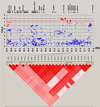Common variants on chromosome 6p22.1 are associated with schizophrenia
- PMID: 19571809
- PMCID: PMC2775422
- DOI: 10.1038/nature08192
Common variants on chromosome 6p22.1 are associated with schizophrenia
Abstract
Schizophrenia, a devastating psychiatric disorder, has a prevalence of 0.5-1%, with high heritability (80-85%) and complex transmission. Recent studies implicate rare, large, high-penetrance copy number variants in some cases, but the genes or biological mechanisms that underlie susceptibility are not known. Here we show that schizophrenia is significantly associated with single nucleotide polymorphisms (SNPs) in the extended major histocompatibility complex region on chromosome 6. We carried out a genome-wide association study of common SNPs in the Molecular Genetics of Schizophrenia (MGS) case-control sample, and then a meta-analysis of data from the MGS, International Schizophrenia Consortium and SGENE data sets. No MGS finding achieved genome-wide statistical significance. In the meta-analysis of European-ancestry subjects (8,008 cases, 19,077 controls), significant association with schizophrenia was observed in a region of linkage disequilibrium on chromosome 6p22.1 (P = 9.54 x 10(-9)). This region includes a histone gene cluster and several immunity-related genes--possibly implicating aetiological mechanisms involving chromatin modification, transcriptional regulation, autoimmunity and/or infection. These results demonstrate that common schizophrenia susceptibility alleles can be detected. The characterization of these signals will suggest important directions for research on susceptibility mechanisms.
Figures

References
-
- Tandon R, Keshavan MS, Nasrallah HA. Schizophrenia, "just the facts"what we know in 2008. 2. Epidemiology and etiology. Schizophr Res. 2008;102:1–18. - PubMed
-
- Cook EH, Jr, Scherer SW. Copy-number variations associated with neuropsychiatric conditions. Nature. 2008;455:919–923. - PubMed
-
- Arnold SE, Talbot K, Hahn CG. Neurodevelopment, neuroplasticity, and new genes for schizophrenia. Progress in brain research. 2005;147:319–345. - PubMed
-
- Adegbola A, Gao H, Sommer S, Browning M. A novel mutation in JARID1C/SMCX in a patient with autism spectrum disorder (ASD) Am J Med Genet A. 2008;146A:505–511. - PubMed
Publication types
MeSH terms
Grants and funding
- R01 MH061675/MH/NIMH NIH HHS/United States
- MC_U105292688/MRC_/Medical Research Council/United Kingdom
- U01 MH046276/MH/NIMH NIH HHS/United States
- U01 MH079469/MH/NIMH NIH HHS/United States
- R01 MH067257/MH/NIMH NIH HHS/United States
- U01 MH079470/MH/NIMH NIH HHS/United States
- R01 MH059587/MH/NIMH NIH HHS/United States
- R01 MH059586/MH/NIMH NIH HHS/United States
- U01 MH046289/MH/NIMH NIH HHS/United States
- R01 MH059566/MH/NIMH NIH HHS/United States
- R01 MH060870/MH/NIMH NIH HHS/United States
- R01 MH081800/MH/NIMH NIH HHS/United States
- R01 AG037132/AG/NIA NIH HHS/United States
- R01 MH059571/MH/NIMH NIH HHS/United States
- R01 MH059565/MH/NIMH NIH HHS/United States
- R01 MH059588/MH/NIMH NIH HHS/United States
- U01 MH046318/MH/NIMH NIH HHS/United States
- G0801418/MRC_/Medical Research Council/United Kingdom
- U54 RR020278/RR/NCRR NIH HHS/United States
- R01 MH060879/MH/NIMH NIH HHS/United States
LinkOut - more resources
Full Text Sources
Other Literature Sources
Medical
Molecular Biology Databases

